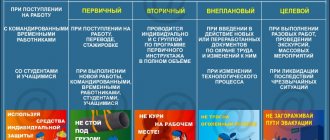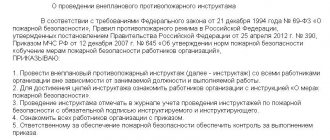Rate this article!
Stop. Before you object, listen. We understand perfectly well that there is no universal workplace safety instruction. If only because jobs are different. Someone works at a machine, and someone at a computer in the office. By the way, the latter can be completely exempted from on-the-job instruction. But every instruction on TB in the workplace has uniform rules, the inclusion of which in the document we will analyze today.
What does the workplace safety instruction consist of?
Workplace safety instructions, like any labor protection instructions, consists of 5 sections. In which of them should we look for universality?
- general labor protection requirements (here will be the most points);
- labor protection requirements before starting work (very few, but there are);
- labor protection requirements during work (don’t even look: different jobs – different requirements);
- safety rules after finishing work (here we will find several general provisions);
- safety requirements in emergency situations (emergency situations also vary, but there are a couple of points).
Initial briefing
Initial training is carried out with employees before they are allowed to work independently. This point is clearly stated in the legislation (clause 2.1.4 of the Resolution of the Ministry of Labor, Ministry of Education dated January 13, 2003 No. 1/29).
Legislators prescribed this important point for a reason. No matter how excellent a diploma a new employee has, no matter how well and for many years he has worked in another company, there are always nuances in a new workplace. Important nuances that can affect a person’s health, and sometimes simply take his life. The new employee must be fully aware of all the hazards in the new workplace.
Example
A 25-year-old man died on the territory of one of the mechanical repair shops. At the time of the tragedy, he had been working at his new place as a turner for only a week. In the morning, the man went out for his shift and began making parts on a lathe. As he reached toward the far side of the machine, the sleeve of his clothing was caught between the moving parts of the mechanism. When colleagues noticed this, they stopped the machine and called doctors, but it was too late. The worker received non-life-threatening injuries and died on the spot. As it turned out during the investigation of the accident, the immediate supervisor of the deceased did not give him initial instructions and did not explain how to work correctly on this machine and what clothes were prohibited from wearing.
Lesson No. 1 - who conducts the initial briefing?
Unlike induction training, initial training at the workplace is required by law not to be conducted by a labor protection specialist, but by the employee’s immediate supervisor - foreman, foreman, teacher, etc. (clause 2.1.4 of the Resolution of the Ministry of Labor, Ministry of Education dated January 13, 2003 No. 1/29).
A mandatory requirement is that the manager who conducts the initial briefing must undergo occupational safety training and a knowledge test of occupational safety requirements.
Lesson No. 2 - with whom the initial briefing is carried out
Initial training at the workplace is carried out with certain categories of workers specified in the law (clause 2.1.4 of the Resolution of the Ministry of Labor, Ministry of Education dated January 13, 2003 No. 1/29).
These include:
- New employees of the organization hired under an employment contract on a permanent basis.
- Employees hired under a fixed-term employment contract, including for a period of less than 2 months.
- Seasonal workers, part-time workers, homeworkers, if they use the employer’s materials and tools in their work.
- Employees who were transferred from another structural unit or assigned to perform new work that is unusual for them.
- Seconded workers of third-party organizations.
- Students who undergo practical training at the enterprise.
- Other persons who participate in the production activities of the organization.
But if the employer is firmly confident in his decision to exempt some employees from initial instruction, he is obliged to approve the list of professions and positions of employees exempt from initial instruction (clause 2.1.4 of the Resolution of the Ministry of Labor, Ministry of Education dated January 13, 2003 No. 1/29).
Lesson No. 3 - how to conduct initial briefing
Initial training can be carried out individually with each employee or with a group of employees who service the same type of equipment at one workplace.
Initial briefing is carried out on the basis of the initial workplace training programs developed by the organization.
Such programs are developed by the heads of the structural unit. The document must be agreed upon with a labor protection specialist. He, in accordance with his duties, must coordinate the development of programs and provide methodological assistance. This is indicated in the professional standard of a labor protection specialist (Order of the Ministry of Labor of Russia dated August 4, 2014 No. 524n).
The program is developed on the basis of regulatory legal acts, taking into account the specifics of the organization’s activities, structural units, labor protection instructions, technical and operational documentation. The program is agreed upon by the labor protection specialist and the company's trade union, the employer approves.
List of basic issues of initial training in the workplace that need to be included in the program of initial training in the workplace:
- General information about the employee’s working conditions: the technological process, equipment and production environment at the employee’s workplace, the nature of his work process.
- The procedure for preparing for work in the workplace.
- Scheme of safe movement of an employee throughout the territory of a department or organization.
- Emergency situations that may occur in the workplace.
It is necessary not only to conduct an initial briefing with the employee, but also to check how much he has mastered his knowledge. This must be done through an oral interview.
Lesson No. 3 - how to record the initial briefing
After the employee has been given the initial briefing and the knowledge gained has been tested, the information must be entered into the workplace briefing log. You will find a recommended sample magazine in Appendix A to GOST 12.0.004-2015. It contains fields that must be filled out in order to legally confirm the instructions given:
- the date of the;
- last name, first name and patronymic of the employee (we recommend writing it in full and not shortening it to initials);
- employee's year of birth;
- profession or position of the person being instructed;
- signatures of the person being instructed and the person instructing;
- internship information.
Novice occupational safety specialists often make mistakes when conducting initial and repeated training. An expert from the Qualification and Training Assessment Center No. 1 will tell you about the main mistakes and give useful recommendations.
Workplace safety instructions - general requirements
In this section, the universal requirement is the training of an employee in labor protection. This includes undergoing special training in occupational safety and health and undergoing a preliminary medical examination. And of course, introductory training on labor protection. Otherwise, the employee simply cannot be allowed to enter the workplace.
In the vast majority of cases (if we are talking about blue-collar professions), occupational safety training includes a safety internship.
In addition, any workplace safety instructions can include the employee’s obligation to perform only the work that has been assigned to him.
Procedure and timing of labor safety briefings?
| Type of instruction | In what cases is it carried out? | Who is it for? | Who conducts |
| Introductory | - when applying for a job | to all employees | occupational safety specialist/responsible person appointed by order |
| Primary | - when applying for a job | to all employees Exception: employees who are exempt from training by order of the head of the organization in accordance with clause 2.1.4. Resolution No. 1/29 of January 13, 2003 | immediate supervisor of work appointed by order |
| Repeated | - regularly, at least once every 6 months or at least once every 3 months, if the work is associated with increased danger and this requirement is established by industry regulations on labor protection | to all employees Exception: employees who are exempt from training by order of the head of the organization in accordance with clause 2.1.4. Resolution No. 1/29 of January 13, 2003 | immediate supervisor of work appointed by order |
| Unscheduled | — at the request of supervisory authorities; — after an emergency or accident occurs; — when launching new equipment; — when new labor protection requirements come into force; - after a long production downtime. | the list of employees is determined by order of the head of the organization | immediate supervisor of work appointed by order |
| Target | — when performing one-time work not related to direct job responsibilities; — when eliminating the consequences of accidents and natural disasters; — when performing work according to the work permit; — when organizing public events and excursions. | the list of employees is determined by order of the head of the organization | immediate supervisor of work appointed by order |
Universal points in the “before you start” section
In this section, it will be universal to say that the employee must put on special clothing and put on PPE (personal protective equipment). And be sure to inspect your owl’s workplace for dangers. For example, this could be faulty equipment, tangled wires, or cluttered passages. Or a banal mess in the workplace.
In any safety instructions you will find the phrase that the workplace must be kept clean and tidy. This means that we will include the following in our universal one:
...the employee must make sure that nothing threatens his life or health; inspect your workplace for hazards and malfunctions, and if necessary, eliminate them by notifying the manager.
And only then start working. Oh, by the way: the provision for notifying your immediate supervisor of an incident is also found in every workplace safety instruction.
What does occupational health and safety include in an enterprise?
Managers within the security sector set themselves (or the responsible person) the following tasks:
- compliance with safety when working with electrical appliances and power lines, namely their serviceability, insulation, emergency shutdown systems in the event of a short circuit, etc.;
- creating conditions for individual and general protection from fire - special clothing, an evacuation plan, fire extinguishing means, conducting lectures on rules of conduct, etc.;
- monitoring the serviceability of operating equipment, timely repairs and inspections;
- compliance with the requirements for sanitary and hygienic treatment of common areas - toilets and showers, utility rooms, locker rooms;
- protection from increased noise (sound insulation), dust, chemicals and other impacts on humans;
- temperature control;
- insurance for high-rise and underground work.
A more detailed and specific list of measures must be developed individually, depending on the risks associated with the specifics of production.
From an organizational point of view, TB and labor protection at an enterprise includes several areas:
- Training (lectures, knowledge testing) of all personnel. Instructions are carried out for all levels of employees, as well as for temporarily recruited workers.
- Attention to medical condition. For these purposes, routine medical examinations are carried out, and a physician is always present on site to provide first aid. This category includes the issuance of vacation vouchers, bonuses for harmfulness and other bonuses.
- Monitoring the provision of management positions with all technical and personal protective equipment and compliance with safety and health regulations by employees.
Uniform rules upon completion of work
For some reason, the writers of labor safety instructions often send their workers to the shower after their shift. Of course, it's great if there is such an opportunity. But otherwise, it is better to check this point; it is far from universal.
But the requirement to put all the tools in their storage place and leave the workplace clean is quite common.
At the same time, if an employee deals with electrical appliances, the safety instructions should ask him to turn off the power at the end of the work shift.
Basic filling requirements
Safety Engineer: Responsibilities
The corresponding instructions (for example, instructions on labor protection for an electrician or electrician, etc.) must be developed according to a clearly defined sequence of actions:
- Issuance of an order indicating the position held and the type of job duties for which appropriate instruction is required. This list is subject to further approval.
- Heads of workshops, sections or foremen are engaged in the responsibilities assigned to them in developing instructions.
- The created project is coordinated with the trade union for compliance with the norms of the legislation of the Russian Federation.
- After preliminary approval, the layout is subject to approval by the management of the enterprise. On the title page it is necessary to indicate: the full name of the company, the date of preparation, information about the responsible person who approved the instructions.
- Hired staff, under personal signature, must be familiar with all documentation on labor protection, including: during initial employment, transfer to another position, changes to the initially developed instructions.
- At the next stage, data regarding the rules must be entered into the appropriate logbook for labor protection, for example, at school, and safety in accordance with the norms of the Letter of the Ministry of Labor and other norms of federal legislation.
A typical example of instructions for a mover on duty
Note! The rules are contained in the operating and repair manuals of equipment manufacturers, including technological documentation of a particular enterprise. In addition, specific production conditions are taken into account.
When developing, it is imperative to refer to materials about accidents that occurred at the enterprise. It is necessary to focus on two facts: to exclude repetitions and administrative liability with all the ensuing consequences.
Universal safety requirements in emergency situations
Despite the fact that accidents are also different, there are a couple of common requirements. For example, providing first aid (for example, cardiopulmonary resuscitation or desmurgy), alerting rescue services and the immediate supervisor.
This also includes the rule not to touch anything at the scene of an incident (unless it threatens the health of the employee and his environment). And, perhaps, the most important thing in any workplace safety instructions: the priority of human life over material values.







